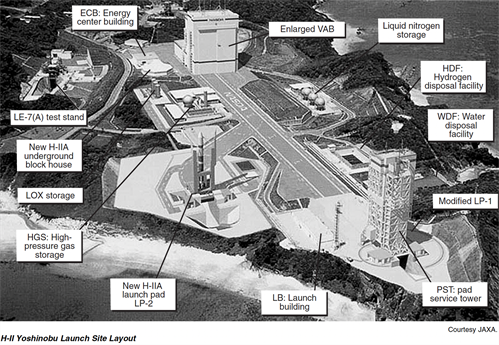H-IIA & H-IIB
NOTE: AIAA only page editing
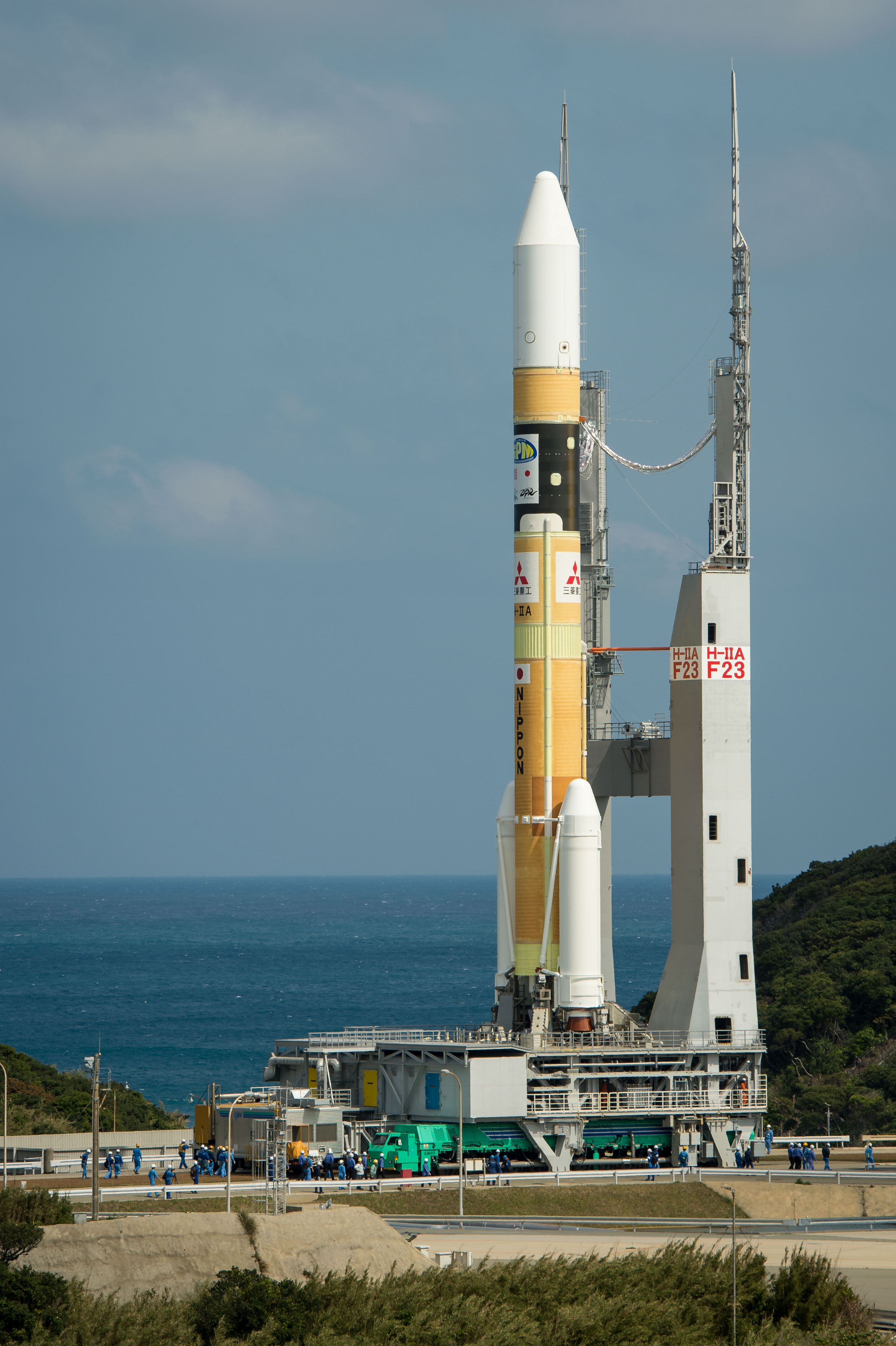
H-IIA rocket carrying the Global Precipitation Measurement Core Observatory rolls out to launch pad 1 of the Tanegashima Space Center, Feb. 27, 2014.
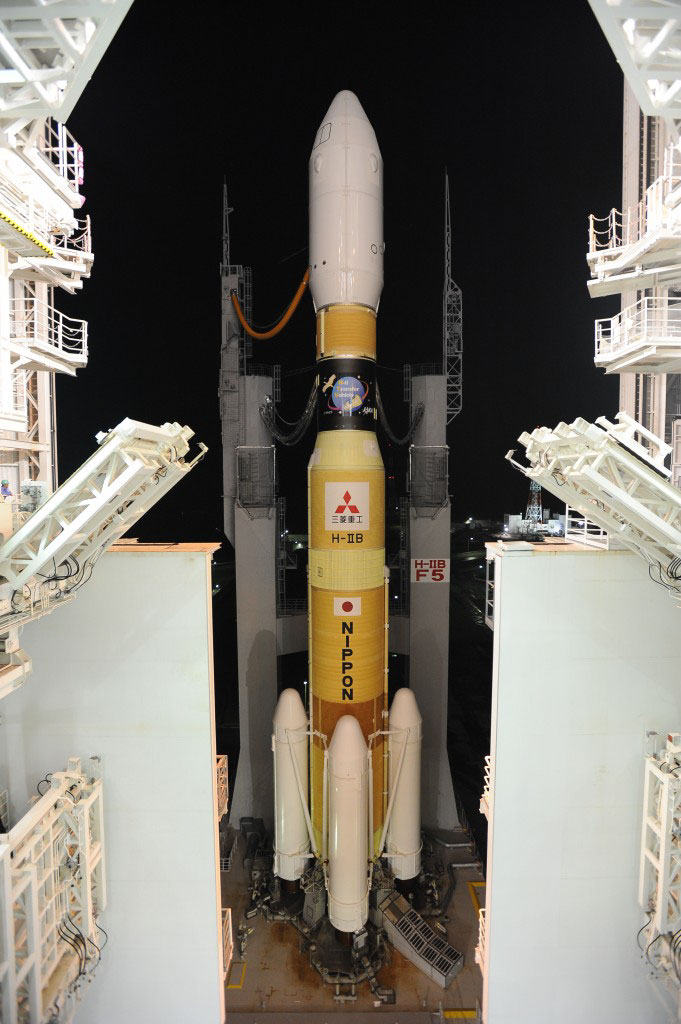
H-IIB rocket carrying the H-II Transfer Vehicle on an International Space Station resupply mission at launch pad 2 of the Tanegashima Space Center, August 19, 2015.
JAXA/Mitsubishi Heavy Industries
H-IIA & H-IIB Vehicle Descriptions
General Description
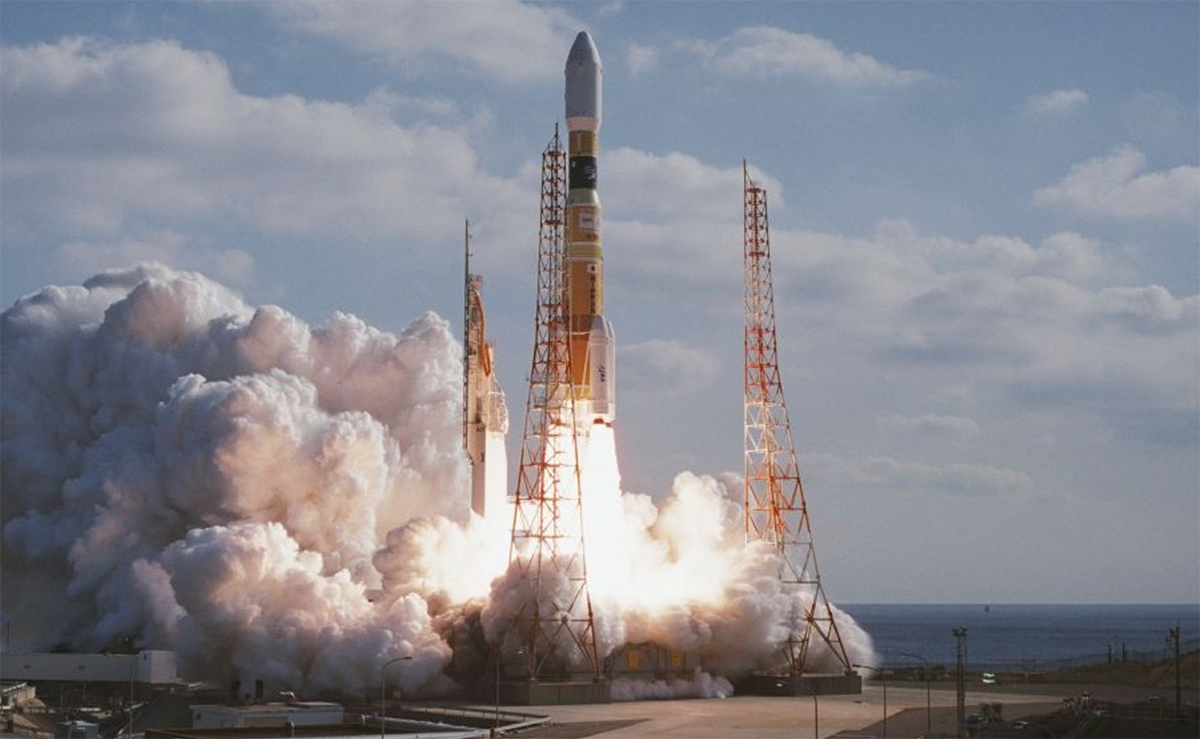
H-IIB rocket launches H-II Transfer Vehicle on an International Space Station resupply mission from launch pad 2 of the Tanegashima Space Center, Sept. 22, 2018. | Source: https://spaceflight101.com/events/h-iib-htv-7/
National Origin
JapanMain Organization
Summary
Flight Rate
Estimated Launch Price
The following costs were published by NASDA, and represent launch costs for government missions, not necessarily prices
that would be charged for commercial launches. They are based on an assumed exchange rate of 120 yen to the dollar.
H-IIA 202: 8.5 billion yen ($70 million)
H-IIA 204: 9.9 billion yen ($83 million)
H3: 6 - 7.8 billion yen ($50-65 million
Spaceports
| Launch Sites | Yoshinobu Launch Complex at Tanegashima Space Center |
| Location | 30.4°N, 131.0°E |
| Available Inclinations | .5–100 deg |
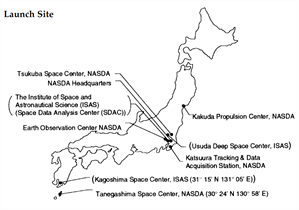 The Tanegashima Space Center is located on the southeastern coast of Tanegashima Island, Kagoshima Prefecture. Tanegashima Island, which is 58 km (36 mi) long with a population of about 40,000, is located 40 km (25 mi) off the southern coast of Kyushu, the southernmost of the four major islands in the Japanese chain. The facilities include the Takesaki Range for sounding rockets and the Osaki Range for space launch vehicles. The center also includes the Masuda Tracking and Data Acquisition Station, the Masuda, Uchugaoka, and Tanegashima radar stations, and three optical tracking stations, as well as test firing facilities for solid and liquid engines. The center occupies approximately 8.6 km2 (3.3 mi2) of land and is the largest launch site in Japan. The major tasks of the center are to check, assemble, and launch rockets, and to perform tracking and control after launch. The center is Japan’s primary site for launching applications satellites and test firing solid rocket motors and liquid rocket engines. As a result of objections from fishing unions to the hazards associated with the launches over their fishing grounds, launch windows are restricted to two launch periods each year. In the past these periods lasted from 15 January to 28 February and 1 August to 15 September. However, JAXA has negotiated an increase in the duration of the available launch periods, to support higher flight rates. The new periods cover 1 January through 28 February, and 22 July through 30 September. In addition, two 60-day periods encompassing June to July and November to December are available as launch windows for high-priority launches such as planetary or international missions.
The Tanegashima Space Center is located on the southeastern coast of Tanegashima Island, Kagoshima Prefecture. Tanegashima Island, which is 58 km (36 mi) long with a population of about 40,000, is located 40 km (25 mi) off the southern coast of Kyushu, the southernmost of the four major islands in the Japanese chain. The facilities include the Takesaki Range for sounding rockets and the Osaki Range for space launch vehicles. The center also includes the Masuda Tracking and Data Acquisition Station, the Masuda, Uchugaoka, and Tanegashima radar stations, and three optical tracking stations, as well as test firing facilities for solid and liquid engines. The center occupies approximately 8.6 km2 (3.3 mi2) of land and is the largest launch site in Japan. The major tasks of the center are to check, assemble, and launch rockets, and to perform tracking and control after launch. The center is Japan’s primary site for launching applications satellites and test firing solid rocket motors and liquid rocket engines. As a result of objections from fishing unions to the hazards associated with the launches over their fishing grounds, launch windows are restricted to two launch periods each year. In the past these periods lasted from 15 January to 28 February and 1 August to 15 September. However, JAXA has negotiated an increase in the duration of the available launch periods, to support higher flight rates. The new periods cover 1 January through 28 February, and 22 July through 30 September. In addition, two 60-day periods encompassing June to July and November to December are available as launch windows for high-priority launches such as planetary or international missions.
Launch Facilities
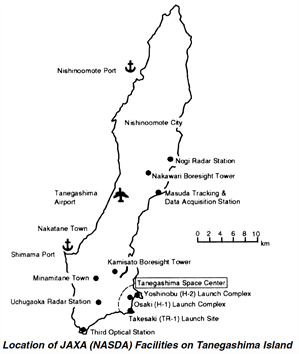 Construction of the Yoshinobu Launch Complex for launching H-II rockets at the
Osaki Range was begun in 1985. The major facilities in the complex are the
Vehicle Assembly Building (VAB), the mobile launcher (ML), two launch pads, the
blockhouse, and propellants and high-pressure gas storage. Adjacent to those
facilities, a test stand was constructed to conduct firing tests of the LE-7 and LE-
7A. An x-ray computer tomography facility is available for nondestructive inspections
of SRBs. Launch operations are controlled from within the octagonal
Yoshinobu blockhouse and directed from the Takesaki Range Control Center.
The VAB is a 66-m (215-ft) high structure with two bays for vertical stacking of
launch vehicles. The second bay was added for the H-IIA program to support the
planned increase in flight rates. While the H-II program performed only vehicle integration
and basic checkout in the VAB with most tests performed after rollout to the
launch pad, the H-IIA is designed to perform all tests in the VAB and is rolled out to
the pad less than 24 h before launch. The launch vehicle is assembled on the deck
of one of two MLs. Major umbilicals to the vehicle and payload are routed through
service masts mounted on the ML. When vehicle integration and testing are complete
and the spacecraft has been mated to the launch vehicle, the booster is carried
by the ML along a 500-m (1600-ft) route to the launch pad.
There are two launch pads at the Yoshinobu Launch Complex. Launch Pad 1,
built for the H-II program, includes a large Pad Service Tower (PST). The PST
stands 75 m (245 ft) high. It consists of a fixed service structure and two rotating
service structures that can open to both sides before launch. The fixed service
structure includes work platforms at different levels to access the vehicle,
and a 20-ton bridge crane to lift the encapsulated fairing and payload into place.
Launch Pad 2, built for the H-IIA, is a simple “clean pad” design with no access
tower, reflecting the simplified operations sequence for the H-IIA. All interfaces
to the launch vehicle are provided by the umbilical masts on the ML.
Construction of the Yoshinobu Launch Complex for launching H-II rockets at the
Osaki Range was begun in 1985. The major facilities in the complex are the
Vehicle Assembly Building (VAB), the mobile launcher (ML), two launch pads, the
blockhouse, and propellants and high-pressure gas storage. Adjacent to those
facilities, a test stand was constructed to conduct firing tests of the LE-7 and LE-
7A. An x-ray computer tomography facility is available for nondestructive inspections
of SRBs. Launch operations are controlled from within the octagonal
Yoshinobu blockhouse and directed from the Takesaki Range Control Center.
The VAB is a 66-m (215-ft) high structure with two bays for vertical stacking of
launch vehicles. The second bay was added for the H-IIA program to support the
planned increase in flight rates. While the H-II program performed only vehicle integration
and basic checkout in the VAB with most tests performed after rollout to the
launch pad, the H-IIA is designed to perform all tests in the VAB and is rolled out to
the pad less than 24 h before launch. The launch vehicle is assembled on the deck
of one of two MLs. Major umbilicals to the vehicle and payload are routed through
service masts mounted on the ML. When vehicle integration and testing are complete
and the spacecraft has been mated to the launch vehicle, the booster is carried
by the ML along a 500-m (1600-ft) route to the launch pad.
There are two launch pads at the Yoshinobu Launch Complex. Launch Pad 1,
built for the H-II program, includes a large Pad Service Tower (PST). The PST
stands 75 m (245 ft) high. It consists of a fixed service structure and two rotating
service structures that can open to both sides before launch. The fixed service
structure includes work platforms at different levels to access the vehicle,
and a 20-ton bridge crane to lift the encapsulated fairing and payload into place.
Launch Pad 2, built for the H-IIA, is a simple “clean pad” design with no access
tower, reflecting the simplified operations sequence for the H-IIA. All interfaces
to the launch vehicle are provided by the umbilical masts on the ML.
Production and Launch Operations
Primary Missions
Intermediate GTO and LEO payloads
Status
Key Organizations
Marketing Organization
Launch Service Provider
Prime Contractor
Performance
A single-payload 4-m fairing is assumed for the performance given below, unless otherwise noted. A standard 100-kg adapter is accounted for. Performance for polar orbits is higher for launches in winter than in the summer. Winter values are shown. Performance shown reflects full-length first-stage nozzle. Performance on initial launches with short nozzle is slightly lower.
| 300 km (162 nmi), 30.4 deg | H2A202: 10,000 kg (22,000 lbm) H2A204: 15,000 kg (33,000 lbm) |
| 185 km (100 nmi), 90 deg | ? |
| Space Station Orbit: 407 km (220 nmi), 51.6 deg | H2A202: 8400 kg (18,500 lbm) |
| Sun-Synchronous Orbit: 800 km (432 nmi), 98.6 deg | 5-m payload fairings H2A202: 4350 kg (9590 lbm) |
| GTO: 250 36,226 km (135 19,560 nmi), 28.5 deg | H2A202: 4200 kg (9300 lbm) H2A204: 6000 kg (13,200 lbm) |
| Geostationary Orbit | No capability |
Flight Record (through 31 July 2021)
The performance capability quoted below includes the spacecraft mass plus the mass of any required adapter and/or dual payload structures.
| H-II | H-IIA | H-IIB | H-II Family Total | |
| 300 km (162 nmi), 30.4 deg | 8 | 43 | 9 | 60 |
| 185 km (100 nmi), 90 deg | 6 | 42 | 9 | 57 |
| Space Station Orbit: 407 km (220 nmi), 51.6 deg | 1 | 0 | 0 | 1 |
| Sun-Synchronous Orbit: 800 km (432 nmi), 98.6 deg | 1 | 1 | 0 | 2 |
